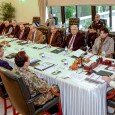By Waqar Gillani –
Stitches in time can save Pakistan from future devastations of already predicted floods
Surrounded by gradually receding water, Muhammad Arshad of town Jalalpur Bhatttian in central Punjab, found his family unprepared and stranded by the floods for many days. “The water came suddenly,” he said. When their mud house failed to stand in the torrential rains followed by huge water incoming in river Chenab, the most dwellers of Punjab like Arshad’s family could also not take refuge on the rooftop.
The house lost cause the family braved the water, gushing in from all sides to look for higher ground. On return after a week, this family of 9, still coping with the effects of the floods and managing to get fully rehabilitated.
Beginning from the first week of September, while coming from Pakistan’s archrival neighboring India, exceptionally high wave of flood in River Chenab and spilling over of River Jehlum due to heavy rainfall in Pakistani and Indian side Kashmir is almost over after two week’s leaving devastating marks on Pakistan’s rural landscape with giving a big jerk to the federal and provincial governments, assumingly, to beware next time. Floodwater has started dropping down in the Arabian Sea since last week of September.
Recent floods, in these two rivers, according to National Disaster Management Authority (NDMA), took more than 359 lives, including many women and children (NDMA has no separate data for that) in various parts of Punjab, Azad Kashmir and Gilgit-Baltistan.
The major death toll is in the largest province of Punjab where at least 282 people lost their lives and large scale devastation is reported. Sixty four died in Kashmir and 13 in GB. The number of damaged houses is more than 56,634 and number of villages affected is around 4,000. Overall, 24, 16,558 acres crops ruined, almost 99 percent in the Punjab which has highest population and agricultural dependency in the rural areas.
Around 9,000 cattle perished. The official figures estimated at least 2.53 million people were affected out of them the government rescue units and Pak Army evacuated and provided relief to around one million people.
Muhammad Riaz, chief meteorologist of the official Flood Forecasting Department in Lahore defended that flood warning system works well. “Actually, there is real need for improvement in water management system and build reservoirs to control floods,” he said, adding, “Pakistan lacks in structural and non-structural management of floods.”
Reservoirs, better canal and irrigation system, embankments development fall in structural issues while mitigation, disaster management, evacuation, and saving people and livestock are non structural issues, he said. “It has nothing to do with climate or its change. This region has a history of continuous floods. The worst flood in River Chenab in Pakistan’s history was in 1957. But in term of scale with the increased population and development the losses are higher than the past this time. Better irrigation means and making reservoirs can help Pakistan in coming out of this flood issue in a better way,” Mr Riaz added.
The government, strangely, found not in a different condition than Asrahd’s family – shocked and wading in waist-high water in places which were previously roads or agricultural fields; and claiming “It was all of sudden.” The administration seemed unready with any rescue plan before the water inundated villages. In rural areas there were no warning and no procedures put in place to deal not only with the water but also the massive flux of people who had to leave their homes.
Prime Minister Nawaz Sharif and his younger brother Shahbaz Sharif, chief minister Punjab, were seen on lightning visits to the flood affected areas urging their opposition to join hands to save people at this difficult time. PM Sharif, who also visited different areas of Azad Jammu and Kashmir addressing the gatherings, said “This flood was so sudden that our experts remain unaware of it, even the experts in Indian Kashmir too.”
Large scale devastation of 2010 floods is still in the eyes of the people in South Punjab. The Federal Flood Commission (FFC), a body to come up with a comprehensive report on 2010 floods, reportedly, suggested significant improvement of coordination between the NDMA and Provincial Disaster Management Authorities (PDMAs) in police matters; coordination and resource mobilization; and establishment of District Disaster Management Authorities (DDMAs). It also recommended going for the most reliable flash flood forecasting and warning system in Pakistan. There were also suggestions that the government should devise clear policies on relocating dwellers from riverine and katcha areas, put an end to deforestation, introduce proper watershed management system.
Four years down the road, along with this report, the government has also neglected the flood commission report of 2010 in which negligence was indicated and strong measures were suggested to maximum reduce devastations caused by flood.
The government seemed to be suffering from the same structural problems that existed in 2010. No real progress has been made on any front – be it putting place an alarm system for floods, managing the flow of water or ensuring a rapid response for evacuation. “Smaller towns and areas are quite ignored by the government,” observed Elaine Alam, a representative of FACES, an NGO that is seen active to provide relief to the people in affected districts in Hafizabad, Jhang and Chiniot.
“There was a lot of damage here but we had not come across any reports of it in the media or any other place. No relief efforts had reached here and it seemed to have been completely ignored by the government,” she said, adding their focus was mostly on foods and shelters and help in rehabilitation living within the available limited resources.
Health is becoming another major issue, as these people continue to live without proper sanitation or shelter. In areas where the water has still not receded it exacerbates the spread of diseases.
In most areas though the water has begun to recede and the focus of the relief efforts also needs to change. A large number of people affected by the floods come from small towns and are either landless peasants or daily wage laborers. Their test is not yet over. For most the flood waters have swept away their livelihood leaving them in debt they have accumulated over the years, with no savings. “Relief efforts should focus on helping them rebuild their lives now,” says Alam. They have no homes and no economic means of earning to return to.
Failure of structural measures in flood protection are quite evident in the country, where administering breaches in flood protection embankments during high floods is seen as common practice to save the barrages and reservoirs at the cost of people. Political blame game was also seen in the recent past with the breaching of dykes to save urban areas in Jhang and Muzaffargarh. The opposition groups and a large scale of accepted people blames politics behinds such manmade diversions of floods though the Punjab chief minister Shahbaz Sharif told the press that all decisions of breaching dykes were made by a high level technical committee.
“We are victims of political vested interests and mismanagement and no one is coming to us after the water has started receded,” Iftikhar Hussain, a farmer in rural Jhang whose area is largely affected due to breach of Athara Hazari dyke said. The diversion of water has ruined hundreds of villages in this area.
Flood, which affected tens of thousands, appeared as a lucrative moment for anti-India extremist-labeled religious groups like Jamaatud Dawa (JuD) propagating against India and holding the neighbouring country as sole responsible of River Chenab flood by suddenly releasing water from its boundaries to spoil Pakistani agriculture.
Along with government, army, and some non government organizations, people also witnessed a third major force coming up with a larger network. Wearing green and orange colors’ jackets, with private boats and ambulances, the committed volunteers of Jamaatud Dawa from the platform of Falah-e-Insaaniat Foundation (FIF), were seen fully active from Sialkot to Sindh till the water started dropping in the ocean.
“In Sialkot it was very difficult to rescue people because water came all of sudden,” Abdul Rauf, chief of relief operations of JuD said. He said following the water the organization has mobilized its hundreds of workers because this is our religious and human duty to help our brothers and sisters. “We are helping in peoples’ evacuation and providing food to those who are not willing to come out but preferring to live on rooftops to take care of their homes,” he added.
Hafiz Muhammad Saeed, the chief of JuD, termed Indian release of water as Pakistan enmity. “Our PM is sending mangoes as gift to the Indian PM, while on the other side, they are sending floods to us,” Mr. Saeed, who also visited Pakistani Kashmir and parts of affected Punjab to supervise his workers’ relief operation, said, adding. “India has dropped water bomb on Pakistan.”
Hamid Malhi, president Punjab Water Council and a director of Farmers Associates Punjab, said flood has hit the crops of sugarcane, paddy (rice), cotton, mangoes. He said the havoc of the flood continued and also affected parts of such in Sindh destroying cotton crop. “There is no planning from the government side at all and there is no funding available for safeguarding agri-production. There are no reservoirs, no modern channelization of water, and no storage at all. Kala Bagh Dam is must.” He said presently operational two big reservoirs – Tarbela and Mangla – are losing their Million Acre Feet water capacity one percent every year. And there is no water gain except a few MAF increase in the past few years due to rains and floods. For the past 10 years we have not planned dams and already announced dams are still in delay.
He said the scheduled Bhasha and Dasu are not capable of meeting the demand and storing water. “We have also done nothing in introducing modern canals and embankments. We have let the rains and floods ruin and plunder our rural landscape freely, which has not only ruined agricultural productions but affected livestock too. The whole focus of the governments is on urban side. Media has become a powerful but any wrong done in rural areas is seldom highlighted.” He feared that the rulers are making promises to bring improvements in flood and water management after this disaster but they would forget aster this worst time is over.
“For next 10 years the rulers need to close their eyes for urban issues and focus on rural development, especially agriculture which include water storing, better irrigation system and then we can improve a lot. Agriculture and livestock ate engines of our growth.”
 The writer is a senior reporter based in Lahore. He works for The News on Sunday. He tweets @waqargillani
The writer is a senior reporter based in Lahore. He works for The News on Sunday. He tweets @waqargillani
































































































